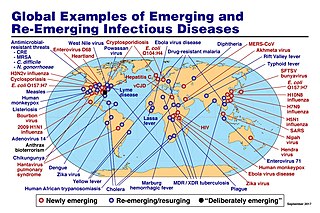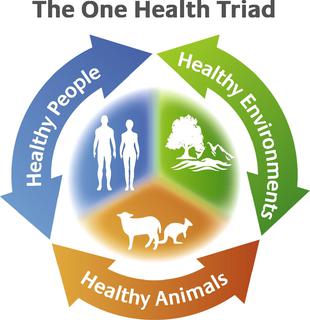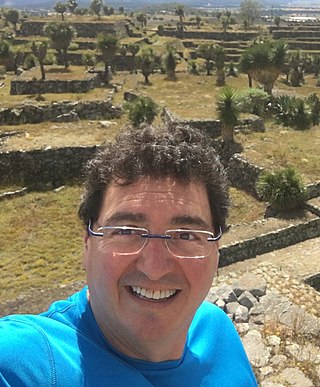
A zoonosis or zoonotic disease is an infectious disease of humans caused by a pathogen that can jump from a non-human to a human and vice versa.

Geophagia, also known as geophagy, is the intentional practice of eating earth or soil-like substances such as clay, chalk, or termite mounds. It is a behavioural adaptation that occurs in many non-human animals and has been documented in more than 100 primate species. Geophagy in non-human primates is primarily used for protection from parasites, to provide mineral supplements and to help metabolize toxic compounds from leaves. Geophagy also occurs in humans and is most commonly reported among children and pregnant women.
In epizoology, an epizootic is a disease event in a nonhuman animal population analogous to an epidemic in humans. An epizootic disease may occur in a specific locale, more generally, or become widespread ("panzootic"). High population density is a major contributing factor to epizootics. The aquaculture industry is sometimes plagued by disease because of the large number of fish confined to a small area.

An environmental hazard is a substance, state or event which has the potential to threaten the surrounding natural environment or adversely affect people's health, including pollution and natural disasters such as storms and earthquakes. It can include any single or combination of toxic chemical, biological, or physical agents in the environment, resulting from human activities or natural processes, that may impact the health of exposed subjects, including pollutants such as heavy metals, pesticides, biological contaminants, toxic waste, industrial and home chemicals.
EcoHealth Alliance is a US-based non-governmental organization with a stated mission of protecting people, animals, and the environment from emerging infectious diseases. The nonprofit focuses on research aimed at preventing pandemics and promoting conservation in hotspot regions worldwide.

An emerging infectious disease (EID) is an infectious disease whose incidence has increased recently, and could increase in the near future. The minority that are capable of developing efficient transmission between humans can become major public and global concerns as potential causes of epidemics or pandemics. Their many impacts can be economic and societal, as well as clinical. EIDs have been increasing steadily since at least 1940.

Health ecology is an emerging field that studies the impact of ecosystems on human health. It examines alterations in the biological, physical, social, and economic environments to understand how these changes affect mental and physical human health. Health ecology focuses on a transdisciplinary approach to understanding all the factors which influence an individual's physiological, social, and emotional well-being.
Disease is described as a decrease in performance of normal functions of an individual caused by many factors, which is not limited to infectious agents. Furthermore, wildlife disease is a disease when one of the hosts includes a wildlife species. In many cases, wildlife hosts can act as a reservoir of diseases that spillover into domestic animals, people and other species. Wildlife diseases spread through both direct contact between two individual animals or indirectly through the environment. Additionally, human industry has created the possibility for cross-species transmission through the wildlife trade.Furthermore, there are many relationships that must be considered when discussing wildlife disease, which are represented through the Epidemiological Triad Model. This model describes the relationship between a pathogen, host and the environment. There are many routes to infection of a susceptible host by a pathogen, but when the host becomes infected that host now has the potential to infect other hosts. Whereas, environmental factors affect pathogen persistence and spread through host movement and interactions with other species. An example to apply to the ecological triad is Lyme disease, where changes in environment have changed the distribution of Lyme disease and its vector, the Ixodes tick. The recent increase in wildlife disease occurrences is cause for concern among conservationists, as many vulnerable species do not have the population to recover from devastating disease outbreaks.

In epidemiology, a disease vector is any living agent that carries and transmits an infectious pathogen to another living organism; agents regarded as vectors are organisms, such as parasites or microbes. The first major discovery of a disease vector came from Ronald Ross in 1897, who discovered the malaria pathogen when he dissected a mosquito.

Gary Tabor is an American environmentalist with over 30 years' experience working on behalf of large scale conservation internationally as well as 12 years as a leader within the U.S. environmental philanthropic community. Tabor is known for his role as a catalyst in forwarding progress through large landscape conservation, pioneering the fields of Conservation Medicine and EcoHealth, and advising agencies and organizations about contemporary environmental issues.

Environmental social science is the broad, transdisciplinary study of interrelations between humans and the natural environment. Environmental social scientists work within and between the fields of anthropology, communication studies, economics, geography, history, political science, psychology, and sociology; and also in the interdisciplinary fields of environmental studies, human ecology and political ecology, social epidemiology, among others.

Gladys Kalema-Zikusoka is a Ugandan veterinarian and founder of Conservation Through Public Health, an organisation dedicated to the coexistence of endangered mountain gorillas, other wildlife, humans, and livestock in Africa.

One Health is an approach calling for "the collaborative efforts of multiple disciplines working locally, nationally, and globally, to attain optimal health for people, animals and our environment", as defined by the One Health Initiative Task Force (OHITF). It developed in response to evidence of the spreading of zoonotic diseases between species and increasing awareness of "the interdependence of human and animal health and ecological change". In this viewpoint, public health is no longer seen in purely human terms. Due to a shared environment and highly conserved physiology, animals and humans not only suffer from the same zoonotic diseases, but can also be treated by either structurally related or identical drugs. For this reason, special care must be taken to avoid unnecessary or over-treatment of zoonotic diseases, particularly in the context of drug resistance in infectious microbes.

The concept of One Health is the unity of multiple practices that work together locally, nationally, and globally to help achieve optimal health for people, animals, and the environment. When the people, animals, and environment are put together they make up the One Health Triad .The One Health Triad shows how the health of people, animals, and the environment is linked to one another. With One Health being a worldwide concept, it makes it easier to advance health care in the 21st century. When this concept is used, and implied properly it can help protect and save the lives of both people, animals, and the environment in the present and future generations.

Jonna Ann Keener Mazet is an American epidemiologist and Executive Director of the University of California, Davis One Health Institute. Recognized for her innovative and holistic approach to emerging environmental and global health threats, she is an elected member of the National Academy of Medicine and a fellow of the American Association for the Advancement of Science. Mazet is a professor of Epidemiology and Disease Ecology at the UC Davis School of Veterinary Medicine, where she focuses on global health problem solving, especially for emerging infectious disease and conservation challenges.

Wildlife trafficking practices have resulted in the emergence of zoonotic diseases. Exotic wildlife trafficking is a multi-billion dollar industry that involves the removal and shipment of mammals, reptiles, amphibians, invertebrates, and fish all over the world. Traded wild animals are used for bushmeat consumption, unconventional exotic pets, animal skin clothing accessories, home trophy decorations, privately owned zoos, and for traditional medicine practices. Dating back centuries, people from Africa, Asia, Latin America, the Middle East, and Europe have used animal bones, horns, or organs for their believed healing effects on the human body. Wild tigers, rhinos, elephants, pangolins, and certain reptile species are acquired through legal and illegal trade operations in order to continue these historic cultural healing practices. Within the last decade nearly 975 different wild animal taxa groups have been legally and illegally exported out of Africa and imported into areas like China, Japan, Indonesia, the United States, Russia, Europe, and South America.
Pandemic prevention is the organization and management of preventive measures against pandemics. Those include measures to reduce causes of new infectious diseases and measures to prevent outbreaks and epidemics from becoming pandemics.

David Hayman is a New Zealand-based epizootic epidemiologist and disease ecologist whose general multi-disciplinary work focuses on the maintenance of infectious diseases within their hosts and the process of emergence and transmission to humans specifically related to bats. He has gathered data on the relationship between ecological degradation due to anthropogenic actions, and increased pathogen emergence in humans and animals. During COVID-19 he was involved as an expert in several international collaborations, some convened by the World Health Organization, and was a regular commentator in the New Zealand media about the country's response to the pandemic. He has had lead roles in research organisations at Massey University and Te Pūnaha Matatini and was the recipient of the 2017 Rutherford Discovery Fellowship Award. Since 2014 Hayman has been a professor at Massey University.

A. Alonso Aguirre is an American veterinarian, wildlife biologist, academic and researcher. He is Professor and Chair of the Department of Environmental Science and Policy, College of Science, and he also chairs the university Institutional Animal Care and Use Committee (IACUC) at George Mason University.

Primate reintroduction is a form of species reintroduction and is the process by which captive or previously free-ranging primates are either translocated or rehabilitated and released into the wild. The goals of primate reintroduction efforts are typically to reestablish or reinforce wild populations, improve the welfare of reintroduced individuals, and/or restore ecosystems. Primate reintroduction is associated with primate rehabilitation which is a form of wildlife rehabilitation that provides care and treatment for individual primates that have been injured, orphaned or abandoned in preparation for reintroduction back into the wild. Rehabilitation and reintroduction together are a strategy to combat the widespread decline of primate biodiversity worldwide and keep primate species and their habitats safe from extinction. The rehabilitated primates are most frequently formerly captive monkeys confiscated or rescued from the illegal pet and bushmeat trades.
















